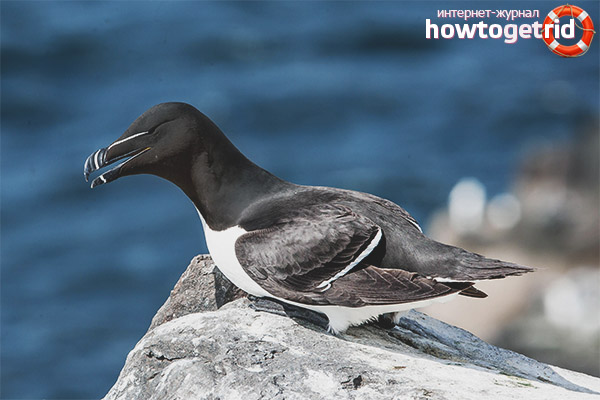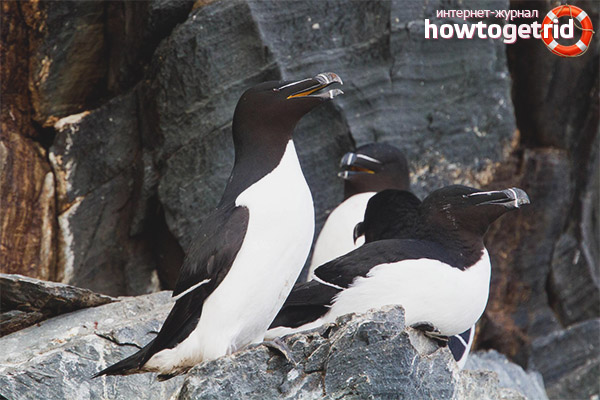The content of the article
Loonies are understood as northern waterfowl, which do not belong to the inhabitants of the air elements. The individuals of this group feel great in the expanses of water, they prefer salty springs, can dive deep and get their own food.
Description
- If you look at the birds in flight, then at first they may seem heavy and awkward to you. In fact, this applies exclusively to those situations when individuals of the breed group are selected on land. They cannot move quickly, they cross from one paw to another with some difficulty.
- Studying this representative of birds from the side of external data, it is necessary to highlight some features in her appearance. So, for example, on the paws there are dense membranes, the neck is short, the individuals themselves are medium-sized and stocky. The beak is thick and raised high, bends upward, flattened from the side parts.
- If you look at the nostrils, they will resemble cracks. The tail is moderately long, can reach 10 cm. It is sharp at the tip and slightly raised. The irises are dark and brownish, the pharynx is yellow and clearly visible.
- The abdominal region is white, while the back is black with brown spots (the head is the same color). When a bird dresses up before the breeding season, it has strips in the area of the eyes and beak, and an oblong mark on the wings.
- As for overall features, these birds grow to a maximum of 20 cm. The final color depends not only on the age of the individual, but also on the time of year. The shade of plumage can vary from light to dark and vice versa.
- The breed group under discussion is often found in the open spaces of the Arctic and Atlantic, more precisely its northern part. Birds are from Europe and the United States of America. They are also found on island territories that belong to or are located next to these countries.
- Most of the population is concentrated in Canada. Each year, more than 50 thousand individuals fly to this country to build a home for future offspring. In normal pastime, these individuals prefer to remain in the open water.
- The voice of the birds is guttural, it creaks as if. Most often, you can hear this when the mating season begins. Since individuals publish something like “gar-gar”, it is for this that they were nicknamed the eons.
- These birds spend most of their time in water, it is logical to say that their main diet is aquatic inhabitants. In particular, we are talking about fish of various species, but not too large (capelin, sprat, cod, etc.). Also, the breed group eats squids, shrimps, crustaceans.
Breeding
- In normal times, the individuals represented spend a lot of time in water. Seabird comes to land only during the mating season. Often this phenomenon occurs in late spring. It can also be noted that the mating season falls on the time before the beginning of the Arctic and cold summers.
- Before young animals are born, adults go in search of food. In this case, the distance from the house can be up to 100 km. After the offspring hatch, the parents no longer leave them for a long time. Often, nesting of such individuals occurs in colonies. And in them there can be other birds.
- Thanks to large colonies, birds of various types can protect themselves from predators. Represented individuals reach puberty at the age of 4-5 years. Before courtship rituals in birds, a courtship period necessarily takes place.
- At this time, in a pair, both individuals preen and try to please each other as much as possible.After the pair has fully formed, the birds begin to mate repeatedly. Moreover, the process can take place up to 80 times!
- It is worth noting that the presented individuals are not involved in the construction of the nest. Often, the female lays only one egg in the coastal cliffs. Dead nests, burrows, cracks in the rocks and all kinds of recesses can act as nests.
- If the place is completely safe, individuals return to it from year to year. Often, birds can independently create a convenient place for masonry from small pebbles. The bottom of such a structure is lined with dried lichen and its own feathers.
- When offspring are involved, both individuals are involved. In this case, the egg may be white or yellowish in color. On one side, red or brown blotches may be observed. The weight of one egg can reach up to 110 g. If a couple loses an egg, often the female does the laying again.
- Under good conditions, the chick is born after 45-50 days. Lunks carefully guard their offspring. However, they do not forget about their own safety. If the birds are scared of anything, they can leave the site for a short time.
- Most often, when the chicks are born, they remain inactive for some time. Young growth is sensitive to cold and completely helpless. The weight of the chick is only 55-60 g. At the same time, it is covered with embryonic fluff of a dark color.
- After half a month, the chick begins to get used to harsh environmental conditions. All this time his parents feed him. Adults bring various fish to the chicks. Often, capelin is included in the diet of young animals.
- Parents continue to patronize the chick a little more than a crescent. After this, the young go on their first trip with adults to the bay or sea. It is worth noting that when the baby begins to get acquainted with water, he is very at risk. The problem is that young animals go to sea, jumping from rocks directly into the raging waves.
Lunks are unique representatives of birds. They have a beautiful appearance. In addition, they live in quite serious climatic conditions. After the young growth, he goes to get acquainted with the water. Moreover, the chicks jump from a cliff into a raging abyss. Often this ends tragically.
Video: Loon (Alca torda)











Submit